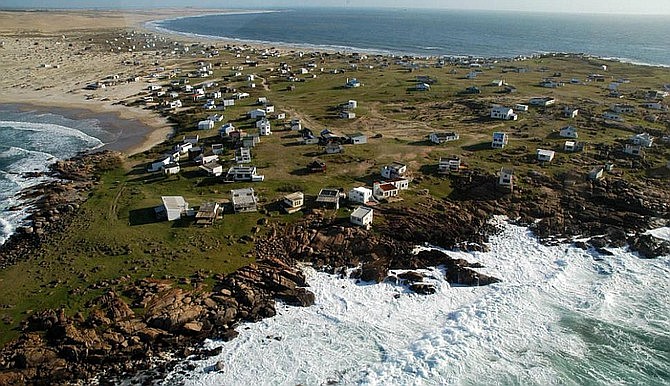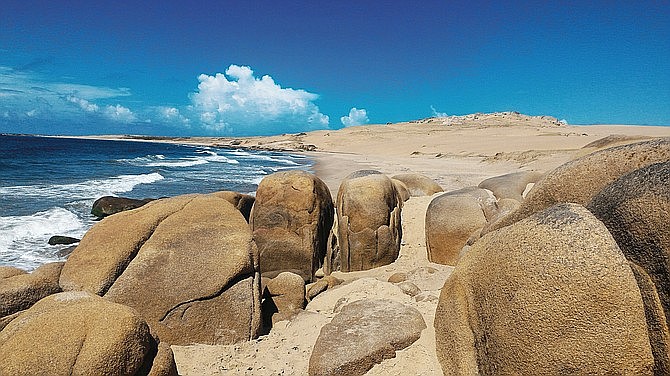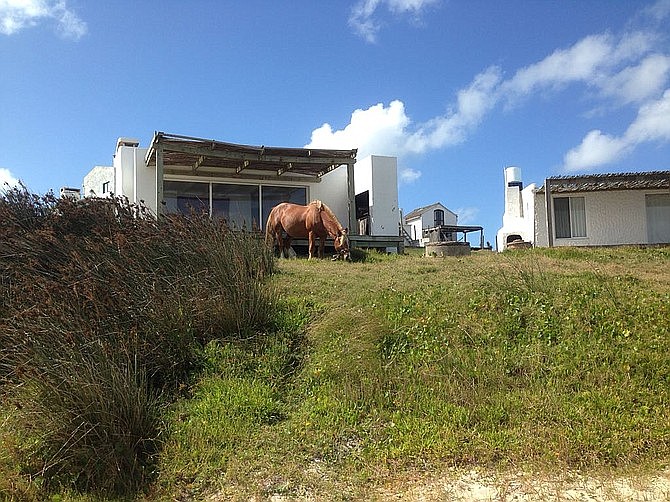 Facebook
Facebook
 X
X
 Instagram
Instagram
 TikTok
TikTok
 Youtube
Youtube

There may well be other places like this, a scruffy village of dwellings on a cape which seems like it’s from another time, but I haven’t seen any. Most locations remind you of some other place that has some similarities, but I have yet to ever meet anybody who’s been able to name one for here.
Cabo Polonio has a vibe all its own in a site that provokes photo frenzies and futile attempts at worthy descriptions.

It started off long ago, like many on Uruguay’s east coast, as a fishing village. There were, and still are, multitudes of sea lions here, which resulted in thousands being slaughtered for their pelts. The shipwrecks off this treacherous point are many and legendary, so the history is bountiful. The blonde bombshell and animal rights activist Bridget Bardot was instrumental in ending the sea lion slaughter, and now there are, once again, loads of them, often barking up a storm.
Now it’s an actual national park, protected territory, and all visitors are encouraged to do their best to keep it clean and pristine. After paying to board a whopper of an all-terrain vehicle to roll seven kilometers through sand dunes and coastal forest, you reach the village. Although the option to walk is available, very few do, as most can’t wait to get there.
And there is something else: an ultra-rustic village with no electricity that’s not generated from solar panels, wind turbines, or gas generators. Besides the well-worn track that the giant shuttles roll in on, there are really no streets, just sandy paths and passageways. Quite a few multicolored cabins, houses, and other structures, and many absolutely ramshackle, as if put together out of a scrap bin. The funkiest community of houses and cabins in one place I've ever seen, with dogs, chickens, horses and hippies running wild.

The resident lighthouse is a masterpiece, one of a network on this coast that are situated every 20 miles or so. This beauty offers a stupefying 360-degree vista of the cape and everything this side of the horizon, including the expansive lair of the sea lions.
Cabo Polonio has become the preferred getaway for urban dwellers in three countries, and fills up with them every January. Accommodations range from basic bunk bed hostels to posh beach cabins with lots of comfort. There are some extra funky digs back away from the beach situated close to the dunes, and some of these can be rented as well, although the methods of contact are usually word of mouth. Those dunes are great fun to wander around, offering sensational views of the entire cape, and I’ve found sizable pools of fresh water here after rainy days — a special, ephemeral treat.

One of the popular diversions is to hike the trail from Cabo to the neighboring town of Valizas, first starting on the beach and then winding inland through the dunes. This can take two to three hours depending on energy and time demands, and a two-mile longer route follows the coast line the entire way, past a superb beach called Playa de Los Huevos directly below the prominent rocky overlook known as Buena Vista.

It used to be the rule to bring as many supplies, food and drink with you as possible, but besides a few essential items, this is no longer the case. With three grocery stores that sell most items at a reasonable cost, including wine and liquor, specialty products now make the most sense. Because of the absence of electricity, locals rely on candlelight for lost illumination, so long burning candles serve a practical need.
When there is rain, there are mosquitoes, so repellent is exceedingly valuable at times as well, although most places have nets. Another essential commodity is suntan lotion; the big light in the sky is powerful and relentless. One of the features here is the lack of trees, so getting out of the sun is not so easy in hot weather. Therefore a hat is an important thing to have, and sometimes the only shade around. I would advise anybody to bring what they can comfortably carry, and I have made the trip toting several bottles of wine and specialty snacks.
If you’re a fan of marijuana, now legal in Uruguay, definitely bring your own, as it is scarce and expensive.
Driving to the entrance station is no problem, but cars are not allowed on the road through the dunes to the village. So taking a bus from Montevideo makes sense, and there are at least three a day. This absence of traffic is another of the positive attributes of the park, both for the lack of noise and fumes. Cabo Polonio has been my favorite place in Uruguay since I first visited, and it’s a must see for every foreign visitor who comes here.
It’s a word that’s frequently overused, and a cliche, but Cabo Polonio is one of the rare places that is, no question, supernatural.


There may well be other places like this, a scruffy village of dwellings on a cape which seems like it’s from another time, but I haven’t seen any. Most locations remind you of some other place that has some similarities, but I have yet to ever meet anybody who’s been able to name one for here.
Cabo Polonio has a vibe all its own in a site that provokes photo frenzies and futile attempts at worthy descriptions.

It started off long ago, like many on Uruguay’s east coast, as a fishing village. There were, and still are, multitudes of sea lions here, which resulted in thousands being slaughtered for their pelts. The shipwrecks off this treacherous point are many and legendary, so the history is bountiful. The blonde bombshell and animal rights activist Bridget Bardot was instrumental in ending the sea lion slaughter, and now there are, once again, loads of them, often barking up a storm.
Now it’s an actual national park, protected territory, and all visitors are encouraged to do their best to keep it clean and pristine. After paying to board a whopper of an all-terrain vehicle to roll seven kilometers through sand dunes and coastal forest, you reach the village. Although the option to walk is available, very few do, as most can’t wait to get there.
And there is something else: an ultra-rustic village with no electricity that’s not generated from solar panels, wind turbines, or gas generators. Besides the well-worn track that the giant shuttles roll in on, there are really no streets, just sandy paths and passageways. Quite a few multicolored cabins, houses, and other structures, and many absolutely ramshackle, as if put together out of a scrap bin. The funkiest community of houses and cabins in one place I've ever seen, with dogs, chickens, horses and hippies running wild.

The resident lighthouse is a masterpiece, one of a network on this coast that are situated every 20 miles or so. This beauty offers a stupefying 360-degree vista of the cape and everything this side of the horizon, including the expansive lair of the sea lions.
Cabo Polonio has become the preferred getaway for urban dwellers in three countries, and fills up with them every January. Accommodations range from basic bunk bed hostels to posh beach cabins with lots of comfort. There are some extra funky digs back away from the beach situated close to the dunes, and some of these can be rented as well, although the methods of contact are usually word of mouth. Those dunes are great fun to wander around, offering sensational views of the entire cape, and I’ve found sizable pools of fresh water here after rainy days — a special, ephemeral treat.

One of the popular diversions is to hike the trail from Cabo to the neighboring town of Valizas, first starting on the beach and then winding inland through the dunes. This can take two to three hours depending on energy and time demands, and a two-mile longer route follows the coast line the entire way, past a superb beach called Playa de Los Huevos directly below the prominent rocky overlook known as Buena Vista.

It used to be the rule to bring as many supplies, food and drink with you as possible, but besides a few essential items, this is no longer the case. With three grocery stores that sell most items at a reasonable cost, including wine and liquor, specialty products now make the most sense. Because of the absence of electricity, locals rely on candlelight for lost illumination, so long burning candles serve a practical need.
When there is rain, there are mosquitoes, so repellent is exceedingly valuable at times as well, although most places have nets. Another essential commodity is suntan lotion; the big light in the sky is powerful and relentless. One of the features here is the lack of trees, so getting out of the sun is not so easy in hot weather. Therefore a hat is an important thing to have, and sometimes the only shade around. I would advise anybody to bring what they can comfortably carry, and I have made the trip toting several bottles of wine and specialty snacks.
If you’re a fan of marijuana, now legal in Uruguay, definitely bring your own, as it is scarce and expensive.
Driving to the entrance station is no problem, but cars are not allowed on the road through the dunes to the village. So taking a bus from Montevideo makes sense, and there are at least three a day. This absence of traffic is another of the positive attributes of the park, both for the lack of noise and fumes. Cabo Polonio has been my favorite place in Uruguay since I first visited, and it’s a must see for every foreign visitor who comes here.
It’s a word that’s frequently overused, and a cliche, but Cabo Polonio is one of the rare places that is, no question, supernatural.
Comments